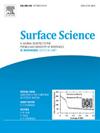Ni(1111)表面碳纳米管早期成核过程的第一性原理研究
IF 2.1
4区 化学
Q3 CHEMISTRY, PHYSICAL
引用次数: 0
摘要
随着工艺技术的不断发展,集成电路的尺寸逐渐缩小,因此,用于互连的空间也在缩小。因此,传统的铜互连正在努力满足日益增长的需求,有必要寻找替代互连材料来取代铜。在众多具有发展前景的材料中,碳纳米管(CNTs)已成为研究热点。然而,通过化学气相沉积(CVD)在硅通孔(tsv)内生长碳纳米管形成互连的挑战目前遇到了与碳纳米管手性和生长温度控制有关的障碍。在本研究中,利用密度泛函理论(DFT)深入研究了在Ni(11 11)表面生长的碳纳米管新生成核阶段的能量学。我们研究了与C2到C4团簇形成相关的能量学,并计算了这些团簇的扩散屏障,结果表明C3的扩散屏障最低。此外,在我们对C5和C6星团形成的能量学计算中,我们考虑了几乎所有可能的情况。该研究对于阐明CVD过程中碳纳米管在Ni(11 11)表面的生长机制具有重要意义。本文章由计算机程序翻译,如有差异,请以英文原文为准。

First principles study on the early nucleation process of carbon nanotubes on Ni (1 1 1) surface
As process technology continues to evolve, the dimensions of integrated circuits are progressively diminishing, and consequently, the space designated for interconnects is likewise shrinking. Consequently, traditional copper interconnects are struggling to fulfill the growing demands, necessitating the search for alternative interconnect materials to supersede copper. Among the various prospective materials, carbon nanotubes(CNTs) have garnered considerable research focus. Nevertheless, the challenge of forming interconnects via the growth of CNTs within through-silicon vias(TSVs) through chemical vapor deposition(CVD) currently encounters hurdles pertaining to the control of CNT chirality and growth temperature. In this investigation, density functional theory(DFT) was utilized to delve into the energetics of the nascent nucleation phase of CNTs growing on Ni(1 1 1) surfaces. We examined the energetics associated with the formation of C2 to C4 clusters and computed the diffusion barriers for these clusters, revealing that C3 exhibits the lowest diffusion barrier. Additionally, in our energetics calculations for the formation of C5 and C6 clusters, we took into account nearly all conceivable scenarios. This research holds paramount significance for elucidating the growth mechanisms of carbon nanotubes on Ni(1 1 1) surfaces during the CVD process.
求助全文
通过发布文献求助,成功后即可免费获取论文全文。
去求助
来源期刊

Surface Science
化学-物理:凝聚态物理
CiteScore
3.30
自引率
5.30%
发文量
137
审稿时长
25 days
期刊介绍:
Surface Science is devoted to elucidating the fundamental aspects of chemistry and physics occurring at a wide range of surfaces and interfaces and to disseminating this knowledge fast. The journal welcomes a broad spectrum of topics, including but not limited to:
• model systems (e.g. in Ultra High Vacuum) under well-controlled reactive conditions
• nanoscale science and engineering, including manipulation of matter at the atomic/molecular scale and assembly phenomena
• reactivity of surfaces as related to various applied areas including heterogeneous catalysis, chemistry at electrified interfaces, and semiconductors functionalization
• phenomena at interfaces relevant to energy storage and conversion, and fuels production and utilization
• surface reactivity for environmental protection and pollution remediation
• interactions at surfaces of soft matter, including polymers and biomaterials.
Both experimental and theoretical work, including modeling, is within the scope of the journal. Work published in Surface Science reaches a wide readership, from chemistry and physics to biology and materials science and engineering, providing an excellent forum for cross-fertilization of ideas and broad dissemination of scientific discoveries.
 求助内容:
求助内容: 应助结果提醒方式:
应助结果提醒方式:


